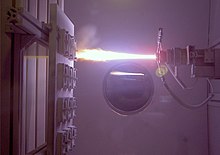Plasma spraying
The plasma spraying (also: plasma coating ) is a thermal coating method or spray method for surface processing.
species
There are different types of plasma spraying (list according to DIN EN 657):
- Atmospheric plasma spray ( APS )
- Inert gas plasma spraying
- Vacuum plasma spraying ( VPS )
- Positive pressure plasma spraying
- Induction plasma spraying
- Liquid stabilized plasma spraying
- Cold plasma spray
Working principle
Atmospheric plasma spray
In atmospheric plasma spraying, an anode and up to three cathodes in a plasma torch are separated by a narrow gap. A DC voltage creates an arc between the anode and cathode. The gas or gas mixture flowing through the plasma torch is passed through the arc and ionized in the process. The dissociation or subsequent ionization generates a highly heated (up to 20,000 K), electrically conductive gas made of positive ions and electrons . In this generated plasma jet, powder (usual grain size distribution: 5–120 µm, with certain devices a grain size of down to 100 nm is possible) is injected, which is melted by the high plasma temperature. The plasma flow entrains the powder particles and hurls them onto the workpiece / component / substrate to be coated . The gas molecules return to a stable state after a very short time, and so the plasma temperature drops again after a short distance. The plasma coating takes place in a normal atmosphere, an inert atmosphere (under protective gas such as argon), in a vacuum or under water. The speed and temperature as well as the composition of the plasma gas are important for the layer quality. Special modifications such as the PTWA (PTWA process for Plasma Transferred Wire Arc) use a wire instead of the powder, which leads to a simpler construction of the torch.
Inert gas plasma spraying
With protective gas plasma spraying, the entire process is carried out with protective gas (usually nitrogen ) as the transport gas . The advantage here is the very low oxidation of the particles between the burner and the substrate.
The gases used are argon , nitrogen , hydrogen , helium or combinations thereof.
application areas
Due to the very different process parameters, a large number of coatings can be implemented, so that there are fields of application in almost every industry. Important industries in which plasma spraying are used are the automotive industry, the paper and printing industry, the aerospace industry, the waste industry and the power generation industry.
Related procedures
- Flame spraying ,
- High speed flame spraying ,
- Detonation syringes ,
- Cold gas spraying ,
- Arc spraying ,
- Plasma powder deposition welding ,
- Laser spraying .
Individual evidence
- ↑ Archived copy ( Memento of the original from December 5, 2014 in the Internet Archive ) Info: The archive link was inserted automatically and has not yet been checked. Please check the original and archive link according to the instructions and then remove this notice.
- ↑ Technology - ecoCOAT GmbH . In: ecoCOAT GmbH . ( eco-coat.com [accessed August 1, 2017]).
